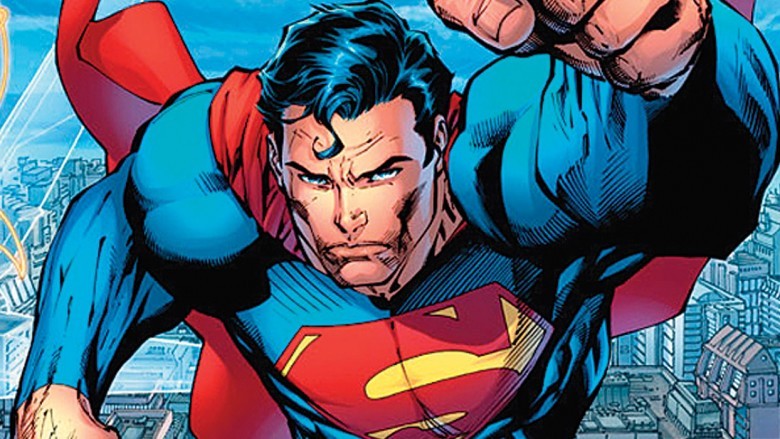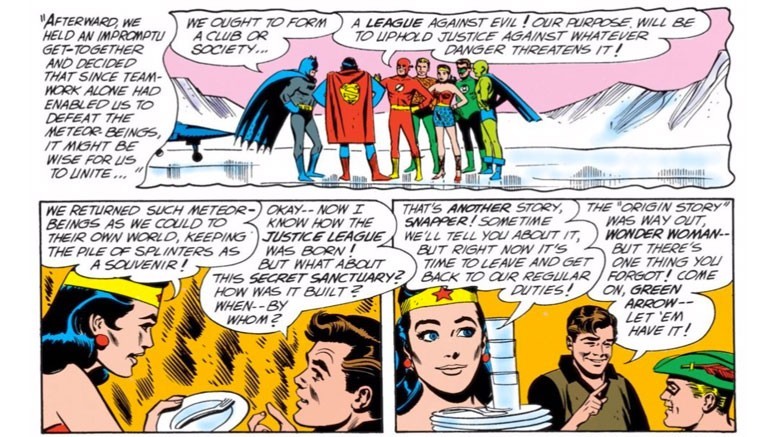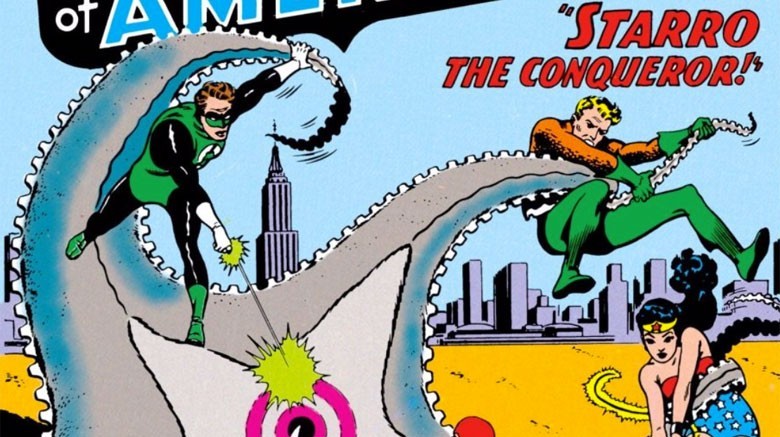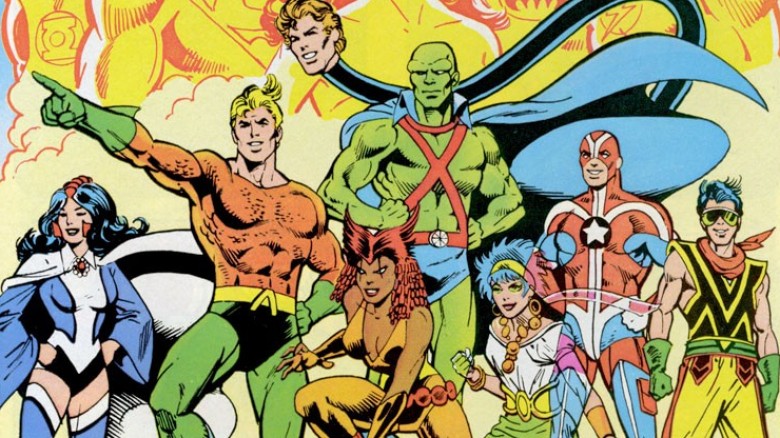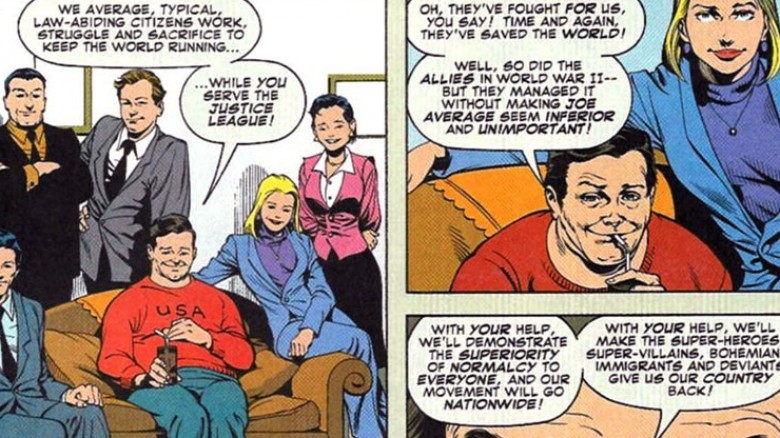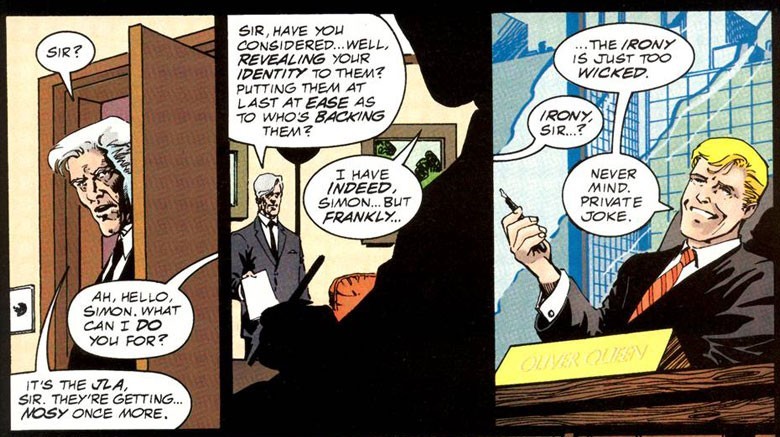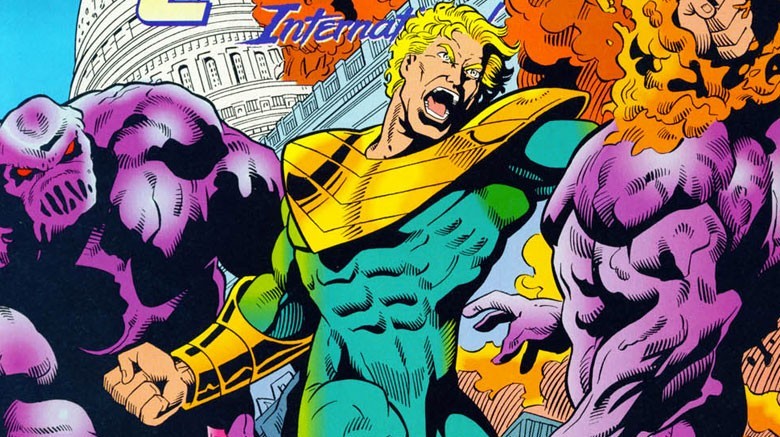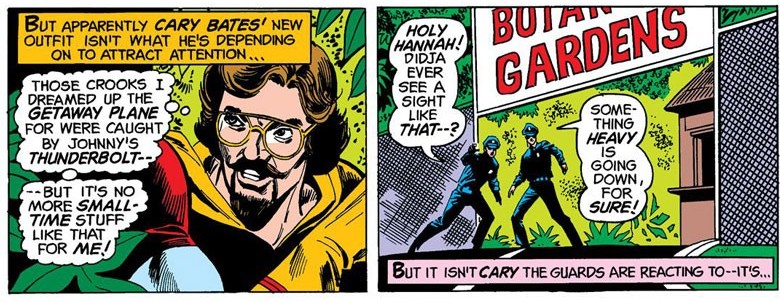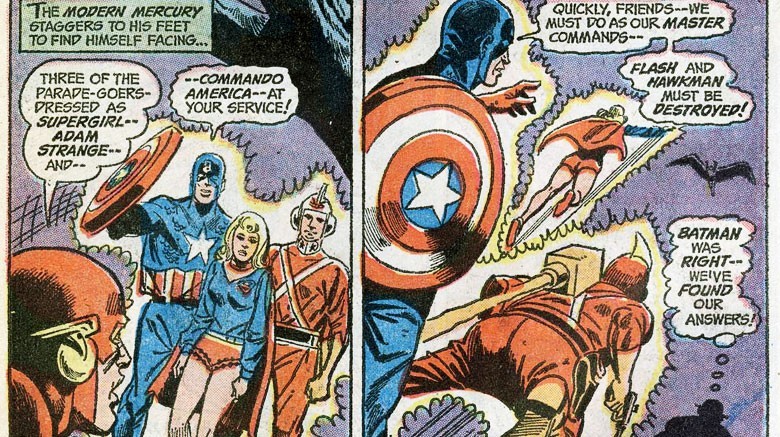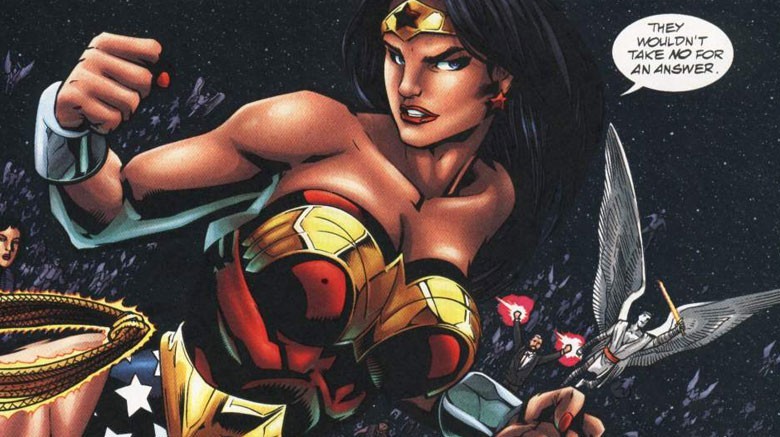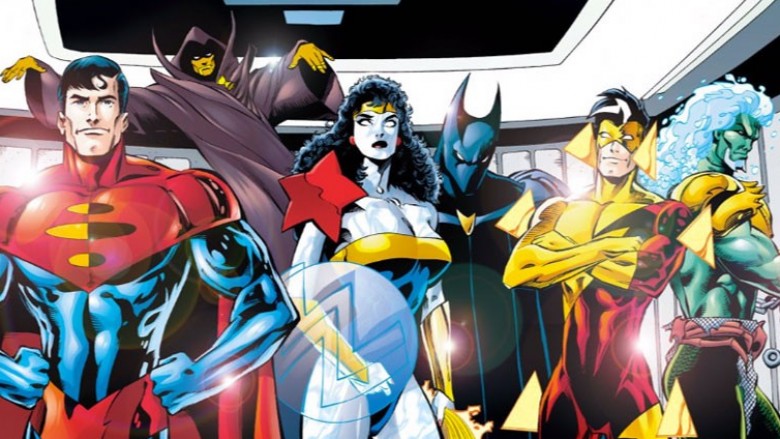What Diehard Fans Don't Even Know About The Justice League
Since their debut in 1960, the Justice League of America has united DC's greatest heroes into a single team dedicated to protecting the Earth from incredibly powerful threats. Or at least, that's the idea. In practice, that long historoy has seen them do a whole lot more than just battle against alien conquerors or world-dominating supervillains.
So much, in fact, that there are plenty of things about the Justice League that even diehard fans don't know—from secret crossovers to shocking villains to the surprising vindictiveness of Aquaman.
They got their name because of baseball
With over 50 years of the Justice League behind us, it's kind of hard to imagine that there was a time when DC just flat-out did not have a major superhero team. And yet, after the original Justice Society of America faded into obscurity along with the majority of its membership—characters like the original Flash and Green Lantern, who would be rebooted into more familiar forms after the '60s started—that's exactly what happened. Superman and Batman would regularly team up with each other, but beyond that, the most prominent DC team at the end of the '50s was probably the Blackhawks. Yeah: We were surprised, too.
In 1962, however, editor Julie Schwartz was riding high off the success of his rebooted Flash and Green Lantern titles, and decided to revive the JSA as his next project, putting all of DC's major superheroes into a single title. The only problem was that, as Schwartz wrote in his autobiography, "Society" sounded a little too high-class. To give the book some fresh appeal for the youth of 1960, he turned to the world of baseball: if kids liked the American League and the National League, then they'd love the Justice League!
That's the behind-the-scenes story, anyway. In Justice League of America #9, when the team finally gets their origin story courtesy of Gardner Fox and Mike Sekowsky, the name comes from the Flash, who interrupts Batman's suggestion of forming a club to loudly announce that they could be a league against evil. Apparently Barry Allen's the baseball fan on the team — and the only one confident enough in his ability to outrun a Batarang to interrupt Batman.
The Justice League's first appearance was also the first time Aquaman made it onto a cover
Most fans of the Justice League can rattle off the team's first appearance—The Brave and the Bold #28—pretty easily. If they've really studied up, they could probably even tell you that the issue also marks the first appearance of Starro the Conqueror, a giant mind-controlling starfish from space that would go on to be one of the team's most enduring opponents, and Snapper Carr, the hip-talking teenage "mascot" for the team whose career would take some truly bizarre twists over the next five decades. There's one other notable first in the issue that's rarely discussed.
Brave and the Bold #28 was the first time that American readers had ever seen Aquaman on the cover of a comic book.
That might not seem like it's all that notable, until you remember that Aquaman was created in 1941. He'd been appearing in stories for almost 20 years, and with the exception of a couple of foreign reprints, no one ever thought that maybe he could be a selling point. Then, to add insult to injury, when he finally did make it to the cover, he was getting trounced by a giant starfish. Seriously: two decades trying to get out from under the shadow of Superboy and Green Arrow, and he's getting taken down by a fish. Making fun of Aquaman might be a cliché at this point, but when they serve it up to us on a platter like that, what are we supposed to do?
Aquaman once kicked everyone else off the team
Of course, it's not all bad for Aquaman. A couple decades after his first cover appearance, he was the only Justice Leaguer available to fend off an alien invasion, a feat so incredible that he followed it up by kicking everyone else off the team. Who gets to be on the cover now, Superman? Who gets to be on the cover of every issue now that the rest of you are gone?!
Okay, fine, so his actual motivations were a little more heroic. Since the League had a responsibility to protect the Earth from threats no one could handle on their own, Aquaman disbanded the League and put a new requirement on membership, declaring that you could only be a member if you could commit to it as a full-time gig. Since everyone else on the team outside of the Martian Manhunter had their own stuff going on—the Joker ain't going to drag himself back to Arkham Asylum, after all—they left, leaving Aquaman to rebuild the team himself.
In practice, this allowed the Justice League to expand and add some diversity to the lineup with flawed but well-intentioned characters like Vibe and Gypsy, but they—and readers—soon figured out that it was probably better to have Superman around part of the time than none of the time. And ironically enough, Aquaman himself would leave after about a year, presumably because the team decided to base themselves out of Detroit. It turns out the Midwest isn't exactly conveniently located for someone who lives in an ocean.
They were once nearly destroyed by their biggest fan
Snapper Carr, so named because of his habit of snapping his fingers, has had one of the weirdest careers in the history of comics. After making his first appearance alongside the Justice League in Brave and the Bold #28, he spent the '60s as their "mascot," a teen sidekick meant to fill the same role for the League as Robin and Jimmy Olsen did for Batman and Superman. In the '80s, invading aliens experimented on him and gave him the power to teleport by snapping his fingers, which led to him briefly leading a team called the Blasters—and then having his hands chopped off by other aliens, losing the ability to teleport even when he got a new set of hands. Then, in 1999, he was briefly the best friend of a time-traveling robot who came from the far future and fell in love with Snapper's ex-wife.
Somewhere in the middle of all that, he almost destroyed the Justice League. The story was originally told in Denny O'Neil and Dick Dilin in 1969's Justice League of America #77—and expanded on by Tom Peyer and Rags Morales 30 years later in Hourman #16—and saw Snapper briefly falling under the sway of John Dough, the Most Average Man in America. See, all Dough wanted was to take America back for normal folks. Oh, and he was secretly the Joker, who really just wanted to break into the League's headquarters, steal all of their weapons, and murder... well, pretty much everyone. And the thing is, he almost did it, prompting the League to relocate from Rhode Island to a slightly more secure HQ in orbit.
Incidentally, the original "Snapper Carr—Super Traitor" was the last story to feature the Silver Age Joker. The Clown Prince of Crime wouldn't appear again for four years before Denny O'Neil and Neal Adams revived him in a darker and more murderous form in "The Joker's Five Way Revenge."
They were originally bankrolled by Green Arrow
One of the perks of living in the DC Universe is that you never really seem to have to worry about money, to the point where there are actually in-continuity reasons for how everything gets funded. Seriously, you would not believe how many stories there are about Aquaman and Superman just heading to the bottom of the ocean and scooping up pirate treasure whenever they need some quick cash. It's like the Silver Age version of hitting up the ATM.
That said, an operation like the Justice League, which comes complete with a secret headquarters and advanced trouble-monitoring technology, raises the question of just who's paying the bills. There's a very likely suspect in the form of Batman—especially since the Justice League fights crime and was originally based out of a cave—but at the end of JLA: Year One, Mark Waid and Barry Kitson revealed that there was someone else paying the League's bills: Green Arrow.
And not only was millionaire Oliver Queen financing the league in secret, he was also doing it after they'd turned him down for membership on several occasions. One assumes that maybe that's why he wrote "maybe recruit that Green Arrow guy, I hear he has an eight pack" in the "memo" section of all the checks.
They had a founding member that everyone forgot about
There are lesser-known characters, there are obscure characters, and then there's Triumph, the superhero so thoroughly forgotten that even the people in his own fictional universe forgot he existed.
He's actually a pretty interesting premise for a character. Created in 1994 by Mark Waid, Brian Augustyn, and Howard Porter, the idea was that Triumph—alias William McIntyre—had not only been a founding member of the Justice League of America, but their original leader. Unfortunately for him, an act of heroism on his very first mission saw him trapped in another dimension for years, while the original timeline shifted to erase him from his previous existence. By the time he got back, everyone had forgotten he was one of the world's greatest superheroes, essentially robbing him of his destiny.
Unfortunately, Triumph wound up rubbing his fellow teammates the wrong way, and didn't fare too well with readers, either. In the end, it turned out that his destiny was always to be a footnote—an interesting footnote, mind you, but a footnote nonetheless.
They once fought their own comics writers
The Justice League has fought plenty of villains over the years, from Darkseid to Lex Luthor to Amazo, but in Justice League of America #123 and 124, they faced two of their most ruthless foes: Elliot S. Maggin and Cary Bates, the guys who were actually writing the comic book.
Believe it or not, this isn't actually as weird as it sounds. The Bronze Age—that weird stretch of time from about 1970 to 1985—featured a lot of stories involving DC's heroes crossing over with "Earth-Prime," the corner of the multiverse that was meant to represent our own real world. This one, however, involved Bates and Maggin accidentally heading over to the Earths of the comics, and, in Bates' case, causing no end of trouble.
Not only does Bates know pretty much everything about the League and their weaknesses, but his journey through dimensions gives him strange powers—like, say, the ability to trap his co-writer in a word balloon while he seemingly murders the Justice Society of Earth-2. In the end, though, Maggin is able to team up with the Spectre—the living embodiment of the Wrath of God—to insult his coworker enough that it snaps him out of his evil trance so everyone can be returned to their proper dimension and spend the next few years with a therapist trying to work out what just happened.
They had an unofficial crossover with the Avengers during Rutland, Vermont's Halloween parade
When the Justice League and the Avengers finally crossed over in 2003 in a story that brought in every member from both teams' considerable history, it was a pretty big deal. The thing is, it wasn't the first time those two teams had brushed up against each other—that actually happened in 1972, in an unofficial crossover based around Rutland, Vermont's real-life Halloween parade.
The parade became an annual event in 1960, and thanks to the fact that organizer Tom Fagan was a huge comics fan, there were plenty of superhero-inspired costumes at the parade every year. So many, in fact, that by 1971, it had been featured in both Avengers and Batman. In 1972, though, Steve Englehart, Gerry Conway, and Len Wein plotted a story that would run in the background of three different comics—two from Marvel and one from DC—on the same night.
The story featured the creators (along with Glynis Wein, Len's wife) taking a road trip to Rutland for the parade that saw them attacked by the Juggernaut and winding up in an issue of Thor. In between, they found themselves in Justice League of America #103, possessed, like many parade goers, by Felix Faust and forced to do battle with the powers of the superheroes they were dressed as. It probably won't surprise you that, since this was a DC Comic, Batman didn't have much trouble disposing of a store-bought "Commando America" or a "bargain-basement web-slinger."
The roster has included an angel from Heaven, a demon from Hell, a talking gorilla, and every single person on Earth
There was a time when the Justice League was an elite enough organization that a hero being offered membership was a big deal—and a hero turning down that offer, like Metamorpho or Black Lightning did—was huge. In the decades since, though, the team has been through enough roster shakeups that virtually every sort of superhero you can imagine has spent some time on the team, including some pretty weird entries.
The angel Zauriel, for instance, was a literal guardian angel who fell in love with the woman he was meant to be watching over, and descended from Heaven to be with her—and also to help the Justice League fight a war against rebellious angels who were trying to destroy the entirety of Creation. On the flip side, when the core team was trapped in the distant past, Nightwing formed a replacement Justice League that featured Etrigan the Demon. Or at least, it featured Jason Blood, Etrigan's human host, but let's be real here: saying Jason Blood's on the league and the Demon's not is kind of like saying that Clark Kent isn't on the team because Superman's the one who got the key. And Congorilla... well, he's a talking gorilla. That doesn't really require much more explanation, does it?
The biggest expansion of the roster, however, came in JLA #41. When Earth was being attacked by Mageddon the Anti-Sun, a primordial annihilation machine that had journeyed to Earth from the far reaches of the galaxy, the last line of defense came when alien technology allowed the League to give every person on Earth super-powers. They all rose up to help Superman, who had been trapped my Mageddon, leading Wonder Woman to refer to them as the "Justice League reserves."
The team continues to exist for another 851 centuries, at least
Considering how much they've managed to accomplish since they first teamed up, it's safe to assume the Justice League won't be going away anytime soon. The thing is, we don't need to doubt it. We know that the team sticks around in one form or another for the next 83,250 years of DC Comics continuity.
Thanks to the wonders of time travel, DC One Million saw the year 1998 receive a visit from the far, far, far future of the 853rd century, where Justice Legion A served as the protectors of the entire solar system. Each member took charge of a different planet, and it's worth noting that the original Superman is still alive in that time, having taken up residence in the sun and acquired a Green Lantern ring, presumably to settle all those "who could win in a fight" debates once and for all.
While Superman might still be around that far in the future, though, most of the Justice Legion's members are just counterparts of the 20th-century league. Their Superman, for instance, is a distant descendant of our own Clark Kent, and their Batman is the warden of a planet-sized asylum for the criminally insane. Oh, and their Flash is actually a time traveler from the 27th century, because if you're going to do a complicated time travel story, you should really just go all out.
